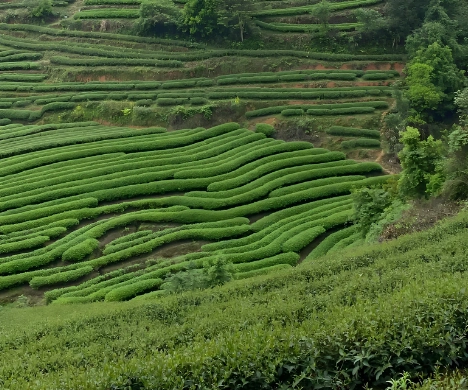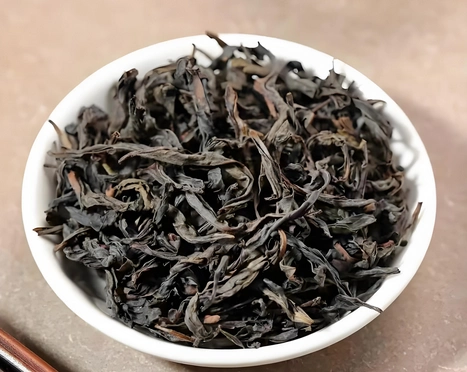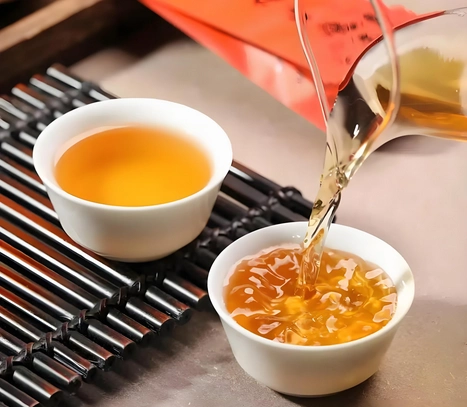The Magic of Oolong Tea Flavors
Oolong tea flavors ignite the senses like a symphony of aroma and taste that dances on your palate. From the first sip, you feel a tapestry of floral notes, subtle fruit undertones, and lingering sweetness that beckons you deeper. Each cup reveals a palette of complexity, inviting exploration and discovery. Whether you crave the delicate whisper of a Light Roast oolong tea or the bold embrace of a High Fire oolong tea, understanding oolong tea flavors unlocks an entire world of sensory delight. Let’s embark on a journey to explore what makes oolong tea flavors so captivating, how terroir and processing shape them, and how you can savor the perfect cup every time.
What Defines Oolong Tea Flavors
The Role of Oxidation in Oolong Tea Flavors
Oolong tea flavors arise from the delicate balance of oxidation, residing somewhere between green tea’s freshness and black tea’s depth. During processing, skilled tea masters carefully bruise the tea leaves, initiating a controlled oxidation that develops complex compounds. As oxidation progresses, enzymes convert fresh green notes into floral and fruity aromas, then into richer honeyed and roasted undertones. The precise level of oxidation—often ranging from 10% to 70%—determines whether the resulting oolong is light and floral or deep and toasty.
For example, a lightly oxidized oolong (10–30%) may offer bright orchid and jasmine notes, guided by tea catechins gently transformed into theaflavins. In contrast, heavily oxidized leaves (60–70%) yield darker, roasted nuances, as polyphenols evolve into thearubigins. The alchemy of oxidation is at the very heart of mastering oolong tea flavors, creating dynamic layers that unfold with each infusion.
How Terroir Shapes Oolong Tea Flavors
Beyond oxidation, oolong tea flavors are profoundly influenced by terroir—soil composition, altitude, humidity, and local climate. Tea gardens perched high in mist-wreathed mountains develop tender buds rich in aromatic oils. Crystal-clear spring water nourishes tea bushes in Fujian’s Wuyi Mountains, infusing mineral notes into Wuyi rock oolong tea. In Taiwan’s high-elevation gardens near Sun Moon Lake, cool nights and sun-kissed days foster oolongs brimming with creamy, orchid-like sweetness.
When you sip a cup of Da Hong Pao or a delicate Phoenix Dan Cong, you taste the very essence of its birthplace—the earth’s minerals, the fragrant forest breezes, and the gentle mist that rouses the leaves at dawn. Each region’s unique fingerprint manifests in subtle differences: a hint of slate-like minerality in a mountain-grown oolong, or a whisper of honeyed fruit in a coastal cultivar. Understanding terroir is essential to appreciating the full spectrum of oolong tea flavors.

Light Roast Oolong Tea Flavors
Floral and Fruity Notes in Light Roast Oolongs
Light Roast oolong tea dazzles with its floral and fruity bouquet—an aromatic overture that captivates the nose and palate simultaneously. These teas, often only 20–30% oxidized and given minimal roasting, showcase the tea plant’s purest essence. Think of notes of gardenia, orchid, and magnolia swirling in the steam, followed by a crisp burst of peach, apricot, or lychee on the tongue. The overall impression is one of delicate elegance, akin to walking through a blooming orchard at sunrise.
Take, for instance, a premium Anxi Tieguanyin or a Taiwanese Jade Oolong: the dry leaves release a sweet perfume of fresh blossoms, while the steeped liquor reveals a bouquet of jasmine and osmanthus. Light roasting preserves these floral and fruit-forward characteristics, producing oolong tea flavors that feel weightless yet intensely fragrant. Sipping such an infusion, you’ll sense the liveliness of spring in each drop.
Brewing Tips to Highlight Light Roast Oolong Tea Flavors
To fully experience the luminous oolong tea flavors in a light roast:
- Use Filtered Water at 85–90°C (185–194°F): Slightly below boiling allows the floral aromatics to bloom without scorching the leaves.
- Steep Briefly (30–45 seconds for First Infusion): This “fast first steep” unlocks bright top notes; subsequent brews can be extended by 30–45 seconds each time.
- Rinse Leaves Quickly (5–10 Seconds): A brief rinse awakens the leaves and clears dust, ensuring a clean, vibrant infusion.
- Gongfu Brewing with a Small Gaiwan or Yixing Pot: Use 5–6g of leaves per 100ml water to spotlight nuanced floral and fruit layers across 4–6 infusions.
With these techniques, oolong tea flavors in light roast teas unfurl like a petal-by-petal revelation—each cup a fresh, fragrant embrace.
Medium Roast and Classic Oolong Tea Flavors
Creamy, Honeyed Undertones in Medium Roast Oolong
As roasters increase the heat and duration, oolong tea flavors evolve from airy florals to creamy, honeyed textures. Medium roast oolongs (around 40–50% oxidation, 2–3 rounds of gentle charcoal roasting) strike a harmonious balance between brightness and depth. These teas often exude a luscious mouthfeel reminiscent of fresh cream, followed by honey-sweet mid-palate notes that linger elegantly.
Consider a classic Wuyi Shui Xian or a Phoenix Dan Cong orchid type: the dry leaves carry a toasty, nutty scent that hints at their roast, yet the steeped liquor reveals a smooth, almost velvety consistency. Floral top notes give way to stone fruit sweetness—apricot or ripe pear—backed by a soft caramel finish. This interplay of creaminess and honeyed layers makes medium roast oolongs versatile and deeply satisfying.
Mouthfeel and Balance of Classic Oolong Flavors
One of the hallmarks of classic oolong tea flavors in the medium roast category is mouthfeel. The tea’s viscosity often coats the tongue, producing a silk-like crescendo that heightens each flavor note. This contributes to a sense of richness without heaviness—an inviting warmth that soothes as it inspires.
- First Infusion: Detect subtle floral or fruit top notes tempered by a whisper of toasty warmth.
- Second and Third Infusions: Revel in fuller, creamier flavors—an interplay of honeyed sweetness and gentle malt.
- Later Infusions: Notice the mineral undertones emerging, hinting at the tea’s mountain or forest origins.
The balance between aroma, texture, and aftertaste in medium roast oolongs creates a contemplative sipping experience, ideal for both casual enjoyment and mindful reflection.
High Fire Oolong Tea Flavors
Deep Toasted and Nutty Accents in High Fire Oolongs
High Fire oolong tea (often 50–70% oxidized, multiple heavy roast cycles) offers oolong tea flavors of profound depth—think toasted nuts, dark caramel, and a lingering smoky allure. Roughly translated, “high fire” means leaves undergo intense charcoal roasting at each stage, imparting a comforting, campfire ember aroma that soothes the senses.
Imagine inhaling a cup of roasted chestnut and almond, woven with maple-like caramel notes that drift like a warm blanket across your palate. Beneath that, you sense a subtle graphite or earth-moss quality, hinting at the tea’s mountain heritage. The overall effect is reminiscent of late autumn: crisp air, fallen leaves, and a mug of warm, spiced beverage crackling at the hearth.
How High Fire Oolong Tea Flavors Differ from Lighter Styles
Compared to the floral brightness of Light Roast oolong tea, High Fire oolong tea immerses you in robust, tactile sensations:
- Intensity: High fire teas dazzle with bolder notes of burnt toffee or cocoa, whereas lighter oolongs whisper floral verses.
- Depth: As you progress through infusions, heavy roast layers persist longer, revealing hidden layers of earthy rock-mineral undertones.
- Aftertaste: Expect a long, smoky-sweet finish—smoke fades slowly, leaving a soft, nutty warmth that lingers in the throat.
When you crave comfort and richness—especially in cooler months or late evenings—High Fire oolong tea delivers oolong tea flavors that feel like a cozy, aromatic embrace.

Dark Oolong Tea Flavors
Smoky, Caramelized Characteristics of Dark Oolongs
Delving further along the roast spectrum, dark oolong tea reveals oolong tea flavors steeped in caramelized sugar and flickering embers. These teas often undergo extended, multi-stage roasting—sometimes over wood fires—infusing leaves with a lantern-like glow of deep amber tea liquor and a captivating smoky profile.
Take, for instance, a deeply roasted Big Red Robe (Da Hong Pao) or Rou Gui. Dry leaves exude a powerful smoke-and-spice aroma, reminiscent of aged mahogany or well-seasoned leather. When steeped, the first infusions introduce cocoa or dried fig sweetness, quickly followed by a wave of toasted chestnut, burnt sugar, and a subtle graphite crispness. The distinction of oolong tea flavors here lies in how robust and multi-dimensional the dark roast can be, offering a sensory tapestry equally reminiscent of dark chocolate and campfire smoke.
Pairing Dark Oolong Tea Flavors with Food
Dark oolong tea’s bold oolong tea flavors pair beautifully with richer, savory dishes and decadent desserts:
- Savory Pairings: Grilled pork skewers, smoky barbecued meats, and hearty noodle dishes find a perfect companion in dark oolongs. The smoky notes echo charcoal-grilled flavors, while the tea’s toffee-like sweetness mitigates any lingering grease.
- Sweet Pairings: Indulge in chocolate lava cake or pecan pie, and the tea’s caramelized edges and roasted core amplify the dessert’s sweetness without overpowering. The lingering smoky finish brings balance, cleansing the palate between bites.
If you’re planning a late-night treat or a hearty BBQ feast, brewing a dark oolong tea will elevate every bite, making the meal unforgettable.
Regional Variations of Oolong Tea Flavors
Fujian Oolong Tea Flavors vs. Taiwanese Oolong Flavors
Across the strait, oolong tea flavors diverge based on regional terroir and processing philosophies:
- Fujian Oolong Tea Flavors: Characterized by mineral “rock rhyme,” especially in Wuyi rock oolongs like Big Red Robe, with a smoky, roasted complexity. Other Fujian styles, such as Anxi Tieguanyin, lean toward floral orchids and baked honey when medium roasted.
- Taiwanese Oolong Flavors: Often emphasize bright floral top notes (orchid, lilac) with a smooth, creamy texture. High-mountain Taiwanese oolongs, grown at 1,000m+ elevations, yield a distinctive “milky” mouthfeel and lingering fruit sweetness. Less roasted styles still focus heavily on punchy floral and fruity exhalations.
When you compare a red-crown Fujian Shui Xian to an Ali Shan or Dong Ding from Taiwan, the contrast in oolong tea flavors becomes striking: Fujian teas often thrum with ancient rock and charcoal warmth, while Taiwanese counterparts shimmer with floral dew and honey.
Specialty Varieties Highlighting Unique Flavor Profiles
Beyond the major regions, unique cultivars offer niche oolong tea flavors:
- Phoenix Dan Cong (Fenghuang) Oolongs: Known for single-bud aromatic profiles ranging from apricot, honey, to ginger and cinnamon. Each specific Dan Cong cultivar paints a different fragrance on the palate.
- Iron Goddess of Mercy (Tieguanyin): Originally from Anxi, this oolong’s lighter roast iterations showcase gardenia and orchid, while deeper roasts reveal honeyed and creamy dimensions.
- High Desert Oolongs: Grown in Yunnan’s high-altitude terroir, these rare teas deliver a subdued floral aroma followed by a rich, honey-roast crescendo that’s undeniably focal.
By sampling these specialty oolongs, you’ll appreciate the breathtaking range of oolong tea flavors—from aromatic fruit gardens to barky, earthy wild landscapes.
Health Benefits Linked to Oolong Tea Flavors
Antioxidants and Metabolism Support in Oolong Tea
One reason oolong tea flavors are celebrated is their connection to wellness. Oolongs contain polyphenols—catechins, theaflavins, and thearubigins—that not only drive aroma and taste but also boost health. These powerful antioxidants:
- Combat Free Radicals: Protecting cells from damage and reducing inflammation.
- Support Metabolism: Enhancing fat oxidation and aiding weight management when consumed regularly.
- Stabilize Blood Sugar: Minimizing post-meal glucose spikes, making oolong an excellent companion to balanced eating.
When you sip an infused cup of oolong, you absorb more than just flavor—you invite a daily dose of protective compounds that nurture your body from the inside.
Stress Relief through Calming Oolong Tea Flavors
Many enthusiasts turn to oolong tea flavors not only for taste but also for tranquility. L-theanine, an amino acid prevalent in oolong, fosters alpha brainwave activity—associated with relaxed alertness. Coupled with moderate, sustained caffeine, oolong delivers:
- Gentle Energy: A clear-headed lift without caffeine jitters.
- Mindful Calm: Floral and creamy notes—especially in light roast and medium roast oolongs—promote slow breathing and mental ease.
- Emotional Comfort: The sensory pleasure of inhaling fragrant steam and sipping warm liquor offers a soothing ritual that mitigates stress.
Whether you choose a fragrant high-mountain oolong before meditation or a dark oolong after a hectic day, those comforting oolong tea flavors can help anchor you in a moment of peaceful clarity.
Choosing and Brewing for Optimal Flavor
Identifying Premium Oolong Tea Based on Flavor Notes
To ensure you experience true oolong tea flavors, look for these markers when selecting tea:
- Leaf Appearance: Premium oolong leaves should be whole, tightly rolled or balled, and show a glossy sheen. Avoid broken leaves or dust that signal lower quality.
- Aroma of Dry Leaves: Gently inhale before brewing. A light roast oolong should exude fresh floral or fruity perfume; a high fire oolong should present a robust, toasted scent.
- Brewing Test: Even a short rinse should reveal aromatic oils—if your rinse smells dull or stale, the tea may be past its prime.
Trust reputable vendors who provide harvest dates, oxidation levels, and roast information. These details help you choose the right tea for your preferred oolong tea flavors.
Brewing Techniques to Maximize Oolong Tea Flavors
Regardless of style, unlocking oolong tea flavors requires mindful brewing:
- Temperature Matters: Light roast oolongs flourish at 85–90°C (185–194°F). Medium roast can handle near-boiling—90–95°C (194–203°F). For high fire and dark oolongs, use full boil (95–98°C, 203–208°F) to coax out deeper roast notes.
- Leaf-to-Water Ratio: Aim for 6g leaves per 100ml water (Gongfu style) or 3g per 250ml (Western style).
- Rinse & Warm: Quick 5–10 second rinse “wakes up” the leaves and clears dust. Warm your vessel to ensure stable steeping.
- Steeping Times:
- Light Roast: 30–45 seconds first infusion; add 15–30 seconds each subsequent steep (up to 6–8 infusions).
- Medium Roast: 45–60 seconds first infusion; add 30–45 seconds per infusion.
- High Fire & Dark: 60–90 seconds first; 45–60 seconds subsequent, extending to 2–3 minutes by the final brews.
By respecting each style’s ideal parameters, oolong tea flavors unfold layer by layer, revealing subtle nuances that reward patience and attention.

To learn more about how to make tea, check out Tbiwencha’s YouTube video explaining how to make tea.
Conclusion: Embrace the Diversity of Oolong Tea Flavors
From misty high-mountain gardens to ancient Wuyi rock cliffs, oolong tea flavors encompass a world of sensory intrigue—floral whispers, honeyed creaminess, toasted walnut warmth, and smoky caramel depths. Each style, from Light Roast oolong tea to High Fire oolong tea and dark oolong tea, offers a unique invitation to explore layers of taste and aroma. By recognizing how oxidation, terroir, and roasting shape these flavors, you empower yourself to choose and brew opulent cups that resonate with your palate.
Whether you’re seeking a calming floral infusion for stress relief, a luxurious afternoon ritual, or a rich cup to savor with dessert, oolong’s multi-dimensional flavors never cease to surprise. Allow yourself to wander through the garden of oolong tea, sampling different varieties, perfecting your brewing, and crafting your own flavor journey. In every cup, there is an opportunity to pause, breathe, and rediscover the exquisite spectrum of oolong tea flavors.



